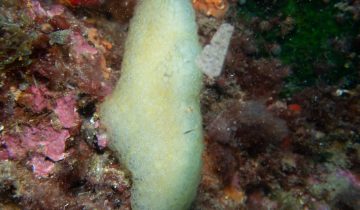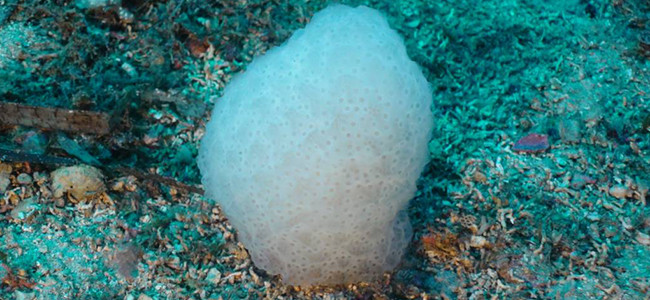Pseudodistoma obscurum is a colonial sea squirt belonging to the order Enterogona and the family Polyclinidae, within the subphylum Tunicata, phylum Chordata. The genus name, Pseudodistoma, refers to its resemblance to other genera in the group, while the specific epithet ‘obscurum‘ alludes to the dark coloration some of its colonial forms exhibit. Commonly known as the dark sea squirt, this species is endemic to the Mediterranean Sea, mainly in its western part, including the Alboran Sea and the Strait of Gibraltar. It inhabits rocky bottoms between 5 and 35 meters depth, both in exposed areas with strong water movement and in calmer environments and coral zones.
From a morphological point of view, Pseudodistoma obscurum occurs in two well-differentiated forms. The first consists of globose, pyramidal, or conical colonies that can reach up to 50 cm in height and are bright yellow without sand incrustations. These forms were previously assigned to Pseudodistoma crucigaster, now considered synonymous. The second morphology features disc-shaped, flat colonies up to 5 cm high and 10 cm in diameter, with a more compact appearance, dark gray or nearly black coloration, and a sandy covering. This last feature gives rise to the name ‘obscurum‘. No similar species are known to be easily confused with it due to these distinctive characteristics.
Pseudodistoma obscurum is a sessile animal that feeds by filtration. Water enters through the oral siphon, protected by tentacles that prevent large particles from passing. This water passes through the pharynx, which contains numerous ciliated slits where planktonic particles become trapped in mucus secreted by the endostyle. Afterwards, the water is expelled through the atrial siphon, carrying away waste. This feeding strategy is common among tunicates and allows them to efficiently utilize phytoplankton and other suspended organic particles.
Regarding reproduction, Pseudodistoma obscurum exhibits both sexual and asexual strategies, as occurs in many colonial ascidians. It is hermaphroditic, although self-fertilization is rare. Asexual reproduction occurs through budding in the stolon, allowing rapid colony expansion under favorable conditions. Sexual reproduction involves external fertilization, resulting in tadpole larvae with a prehensile tail that enables active movement in the environment before settling on a suitable substrate to begin adult development.
One of the most notable characteristics of Pseudodistoma obscurum is its sensitivity to environmental changes. Its presence is associated with clean, well-oxygenated waters, making it a useful bioindicator species for assessing the ecological status of Mediterranean rocky bottoms. It poorly tolerates turbidity, sedimentation, and other anthropogenic disturbances. Like all tunicates, its body is enclosed in an external tunic composed of tunicin, a substance similar to cellulose. This feature has sparked evolutionary interest due to its relation to vertebrates, as they possess homologous structures such as the endostyle, considered a precursor to the thyroid gland in vertebrates.
Photos:

